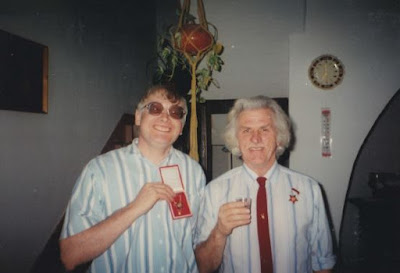09:00 Lois and I tumble out of the shower and after breakfast I start filling the water butts in the back garden. The garden is still producing loads of fruit and veg. We’ve had no rain for a couple of weeks, however, and the water levels are getting lower, although there’s supposed to be rain coming across overnight tonight.
11:00 I get an email from my friend, “Magyar” Mike: as always he
has attached a Hungarian vocabulary test
for me to try.
Since the lockdown started, Mike and I have not been able to meet for our usual Tuesday morning session, but instead we have just exchanged these vocab tests by email every week. This is a desperate effort not to forget all the Hungarian words we have learnt over the last 28 years, since we first started studying the language together.
Flashback to 1994: "Magyar" Mike in happier times – on my first ever visit to Hungary:
me (left) with Mike showcasing for the cameras
our newly acquired
second-hand "excellent worker" medals from the communist era
I send my vocab test to Mike in reply. Mike is finding the long lockdown tedious, he says, especially when the highlight of each week is merely a supermarket visit. Poor Mike - he's not a natural shopper, that's for sure.
I tell him that my
penfriend in Budapest, Tünde, sent me an awful article the other day about Viktor Orbán’s
Hungary. Orbán is trying to deny that Hungary has a problem with a second wave of
coronavirus and he refuses to put any further restrictions on life in the country.
What madness! British visitors returning from Hungary now have to go into 14
days' quarantine on their return to the UK.
The US Ambassador to Hungary, David Cornstein, a Trump-appointee, has just resigned, which seems like one piece of good news – Cornstein has backed Orbán up no matter what.
I point out to Tünde that Cornstein's resignation is potentially a piece of good news for Hungary, although I can’t deny that Trump will probably decide to send somebody even worse as Cornstein’s replacement – it’s a no-win situation, unless the appointment is delayed and Trump doesn’t get re-elected. Yikes!!!
21:00 We watch a bit of TV, the first part in a 3-part documentary
series called “The Secret History of Writing”.
We soon see that this series has a charming presenter in Dr. Lydia
Wilson, but that it proceeds at a truly snail’s pace through the story of the
development of writing. Especially when you consider that after this part there
are another 2 hour-long parts to come – what madness!!!
All the real action in tonight’s programme is condensed into the last 10-15 minutes, which is a bit of a shame. Lois and I knew already that the alphabet we use today is based on the Roman alphabet, which was based on the Greek alphabet, which was based on the Phoenician alphabet.
Writing was originally invented for the use of record-keepers, accountants, storage-keepers, and (sadly) tax inspectors and the like. And, initially, just pictures were used, e.g. a picture, or pictogram, of an ear of barley was written down to represent the concept “barley”, so that you could record how much barley you were storing, or how much tax some barley-owner was liable for – my god!
This picture-based system was later modified to a sound-based system, so that abstract concepts could also be represented. For example the Egyptian word “she-ga” meaning “beautiful” could be represented by 2 pictograms, the pictogram for “she” (which meant “barley”) followed by the pictogram for “ga” (which meant “milk”). So picture of barley plus picture of milk means "beautiful". Simples!
The breakthrough came when people realized it would be even better if you could have a system where each symbol represented just one consonant or vowel sound, i.e. a modern-style alphabet, which you could then use to spell out any word you wanted, as we do today.
The earliest appearance of such an alphabet, resembling the Phoenician one seen later, but dating from about 1850 BC was actually found in carvings left behind by Canaanite migrant workers in the Egyptian turquoise mines of Serabit, in the Sinai desert. A mini-Sphinx has been found with bilingual inscriptions in Egyptian and in Canaanite, with the Canaanite being spelt out in a Phoenician-style alphabet. The inscription refers to the female companion of the Canaanite god, Baal, a sort of "Mrs Baal".
Lois points out, however, that this doesn’t mean that these Canaanite
migrant workers “invented” the alphabet, as the programme seems to imply. It’s
just the earliest known sample of alphabetic script which has happened to survive, and which we
have happened to have stumbled on – and samples of writing are not going to be
common finds when you get to periods of this antiquity, to put it mildly!
The rest is history – the Phoenicians gave the idea to the Greeks, who gave the idea to the Romans, and so on. But it’s interesting that even many of our letters today still show the signs of the original pictures or pictograms that they were derived from. The top of a letter ‘R’ still shows evidence that it was derived from the shape of a person’s head, and the letter ‘A’ still shows signs of a bull’s head complete with horns, just turned upside down. Simples (again) !!!!
22:00 We go to bed – zzzzzzzzzz!!!!!!











No comments:
Post a Comment